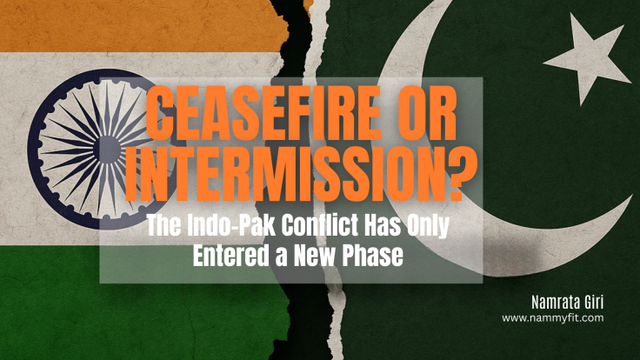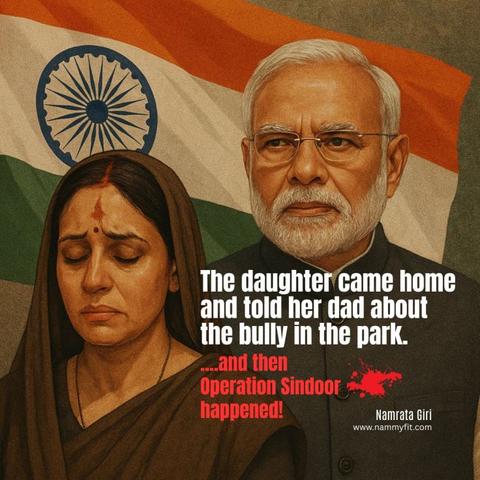Ceasefire or Intermission?
Peace is not a one-sided burden. And India will no longer pay for it alone.
The world may still be calling it a skirmish. On May 9, 2025, what had long simmered beneath diplomatic surfaces turned kinetic.
The India-Pakistan conflict has escalated into a significant military confrontation, with both nations engaging in airstrikes and missile exchanges. India’s Operation Sindoor targeted Pakistani military installations (the sharpest since the 2019 Balakot airstrikes) in response to a terrorist attack in Kashmir that killed 26 civilians. Pakistan retaliated with Operation Bunyan Ul Marsoos, launching strikes on Indian military bases.
Neither side has declared war. While airspace is being locked down and artillery exchanges intensify, the war is no longer about border posts or LoC shelling. This is about strategy, survival, and the beginning of a new regional order.
This is a high-stakes, multidimensional conflict, fought across geography, cyberspace, information, and alliances. India’s posture is notably different this time. It’s not just reactive, it’s strategic. As noted in a 2024 report by the Indian Ministry of Defence, “Any future conflict will be fought across hybrid terrain, where perception, resilience, and control of the narrative are as critical as control of territory.”
The timing is not coincidental. India’s foreign exchange reserves crossed $750 billion in April 2025, making it the fourth-largest globally. It has emerged as the world’s fastest-growing large economy, and its strategic weight in the Global South is undeniable. From defense deals with France to joint Indo-Pacific exercises with the U.S. and Japan, India is no longer a hesitant regional actor.
And the stakes? They’re no longer confined to South Asia. The China–Pakistan Economic Corridor (CPEC), Gulf economic interests, Western investment pipelines, and Asian security architecture are all at risk.
News of a ceasefire is trickling in. But like many, I don’t expect it to last, Pakistan is a bonafide rogue state, and its track record leaves little room for trust. The next war isn’t an “if,” it’s a “when”, and when it comes, India will act with clarity, resolve, and legitimacy. And the consequences won’t stop at South Asia, they’ll shake the global order.
Let’s look at possibilities through the lens of geopolitical probability, not wishful diplomacy.
1. Redrawing of territorial maps in South Asia
South Asia’s map was drawn by colonizers. It may now be redrawn by consequence.
If Pakistan loses strategic coherence, militarily, politically, or economically, these suppressed identities could rapidly evolve into breakaway narratives. The war’s outcomes may not just be about territory, but identity reclamation across fault lines ignored for 75 years.
If the war continues and internal unrest intensifies, Pakistan is likely to fragment. India will reclaim Pakistan-occupied Kashmir (PoK) as a strategic and constitutional priority. But beyond that, deep-rooted ethnic and regional fault lines, Balochistan’s independence movement, Pashtunistan’s revival, and Sindh’s growing discontent, could break Pakistan into multiple entities. A weakened central government, military overstretch, and economic collapse would accelerate this disintegration.
When Pakistan’s western flank collapses into instability, it will fracture its control over the CPEC corridor, drawing China directly into regional negotiations, not as a benefactor, but as a crisis manager.
2. Global oil markets and trade routes face fresh volatility
South Asia is not only a nuclear flashpoint, it also borders some of the world’s most critical oil shipping lanes. A prolonged India–Pakistan war could:
- Disrupt tanker routes from the Strait of Hormuz
- Spark pre-emptive hoarding and price spikes
- Delay regional supply chains across the Middle East and Southeast Asia
Oil prices have historically spiked 10–15% during major Indo-Pak escalations, with Brent crude crossing $90/barrel during the 2019 standoff. [Source: Reuters Market Data Archive]
Gulf countries will be forced to recalibrate; continue backing a fragile Pakistan, or align closer with India, their largest remittance and trade partner.
3. The China–India–Pakistan triangle intensifies global polarization
If India sustains military pressure, China may be compelled to overtly support Pakistan, through intelligence, cyber operations, or border diversions. But that support comes with its own risks. A fractured Pakistan is a CPEC liability and a potential extremist spillover into China’s restive Xinjiang province.
India, in contrast, will likely gain further traction with the U.S., Japan, Australia, France, and other Indo-Pacific allies, who see this conflict as a means of countering Chinese expansionism.
“The India-U.S. relationship today is not transactional; it is transformational.”
– Antony Blinken, U.S. Secretary of State, Indo-Pacific Forum 2023
We may be witnessing a decisive moment in the realignment of Asia’s security architecture.
4. Turkey’s soft war: Opportunism in the name of solidarity
Turkey’s foreign policy under Erdogan has leaned toward pan-Islamic solidarity, and Pakistan has long been a beneficiary. From joint military exercises to coordinated disinformation networks, Turkey’s alignment with Pakistan is ideological and strategic. Turkey has funded cultural propaganda in Kashmir through NGOs and digital outlets. Turkish drones and military tech have already been supplied to Pakistan under earlier defense agreements.
While Turkey won’t directly intervene, atleast immediately, expect it to be a vocal actor in international forums, pressing the OIC, UN, and EU to condemn India, even as Ankara quietly expands its own influence in the Muslim world.
5. NATO: Exposed, divided, and increasingly sidelined
The India–Pakistan conflict may be outside NATO’s geography, but not its implications. This war could expose, test, and potentially splinter NATO’s relevance and unity:Here’s how it pressures the alliance:
NATO’s jurisdiction is technically limited to the North Atlantic region. South Asia, especially India and Pakistan, is outside Article 5 commitments. Yet, globalized supply chains, nuclear risks, and cyber threats from this conflict directly impact European and American security.
If a nuclear incident in South Asia affects global weather or refugee flows, NATO will be forced to act, despite no legal mandate. This creates a credibility crisis: Can the world’s largest military alliance remain passive while global security is threatened?
NATO members will not agree on how to respond. Turkey will likely side with Pakistan (historical military and ideological ties), France and Greece may call for economic and defense support to India, the U.S. will be caught between a strategic partnership with India and past intelligence ties with Pakistan, while Germany and Eastern Europe may push for neutrality.
This reveals NATO’s deeper problem: a lack of unified strategic will outside of Europe.
Add to it the ongoing tensions in Ukraine, the Baltics, and Africa leave NATO stretched thin. A South Asia crisis may force triaging, undermining its global posture.
“In a multipolar world, alliances will be issue-based, not geography-based.”
– IISS Asia-Pacific Security Conference, 2023
The India–Pakistan war may not destroy NATO, but it will expose its limits, accelerating regional security partnerships outside NATO, such as:
- India–France–UAE trilateral cooperation
- QUAD deepening (India, U.S., Japan, Australia)
- AUKUS (Australia, UK, U.S.) expanding footprint
These agile formations bypass NATO bureaucracy, and may begin replacing NATO in Asian scenarios.
6. Cybersecurity and misinformation become weapons of mass disruption
The digital front is already active. As part of its (mis)information warfare, Pakistan has leveraged bot networks and disinformation to flood platforms with fabricated civilian casualty narratives, drawing international sympathy. During the 2019 Balakot airstrike, over 30,000 fake social media accounts were traced to coordinated campaigns originating from Pakistan and Turkey. [Source: EU DisinfoLab]
India, on the other hand, is deploying AI-driven threat intelligence and multilingual narrative counterstrike tools. ️This conflict is a warning bell: The next world war may not start in trenches but on timelines and dashboards.
The world must be prepared for a new South Asia
India may enter ceasefires, but peace with a state that breeds conflict is not a sustainable strategy. As long as Pakistan continues to shelter terrorists and wage asymmetric warfare, any truce is just a pause, not peace.
But here’s the deeper question the world must confront: Why do global financial institutions continue to fund a state that exports terror?
Between 2019 and 2023 alone, Pakistan received over $20 billion in loans and bailout packages from the IMF, World Bank, ADB, and others, despite being repeatedly flagged by FATF for terror financing and money laundering risks.
Where is this money going? Into economic development, or into weapons, propaganda, and proxy networks?
It’s time global institutions are held accountable. You cannot finance stability and fund a defaulter terror state at the same time.
India has no illusions left. The global order must now choose: Will it uphold peace and principles, or continue to enable a regime built on provocation and deceit? Because peace is not a one-sided burden. And India will no longer pay for it alone.
The global community must recognize that this conflict is not a border dispute; it’s a structural fault line. Pakistan’s fragmentation, the redrawing of strategic maps, and shifts in power dynamics are no longer fringe predictions; they are real possibilities.
The world must be ready. Because India is.
References:
Key insights are based on publicly available data from the IMF, World Bank, Asian Development Bank, FATF, and reporting by Reuters, Al Jazeera, Moneycontrol, and official Indian policy sources. For detailed citations, please contact the author.
#AksaiChin #Balochistan #ceasefireAnalysis #FATFGreyList #globalSecurity #IMFLoansPakistan #india #IndiaDefensePolicy #IndiaPakistanConflict #IndoPakCeasefire #LineOfControl #news #nuclearEscalation #pakistan #PakistanFragmentation #Pashtunistan #politics #proxyWar #regionalInstability #Sindhudesh #SouthAsiaGeopolitics #strategicAffairs #terrorismFinancing


